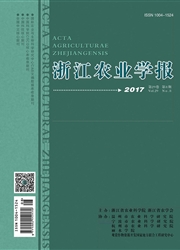

 中文摘要:
中文摘要:
早春晚霜冻害对早熟名优茶生产造成严重危害,为探索茶园防霜方法与技术,研究了晚霜时茶园下垫面气温的变化特点。在分析茶园小气候和晚霜形成的基础上,试验测定茶树冠层上方12 m高度范围内的气温,分析其时空分布特征,以及不同天气条件对成霜的影响。结果表明:在早春晴朗、风速小于0.5 m·s-1的夜晚,当气温降至0℃时,易随辐射逆温的出现而成霜,风速大于2.0 m·s-1或阴雨天时则无霜;逆温约始于傍晚17:30,之后逆温强度迅速增大,最大的逆温差为9.9℃;从20:00至第2日06:00逆温强度波动较平稳,平均波动率为14.1%,其后逆温强度迅速减弱,在8:00左右逆温基本消失;在1:00~6:00时段,近地气温在高度方向上分层显著,(0~3.0),(6.0~7.5) m高度范围的温升变化率较大,分别为1.51℃· m-1和1.58℃· m-1,而(3.0~6.0),(7.5~12.0) m高度范围的温升变化不明显,故6.0~7.5 m可作为防霜风机优选的安装高度。
 英文摘要:
英文摘要:
During early spring , early-maturing superior tea tends to suffer severe late frost damage .Temperature vari-ation of underlying surface of tea plantation was studied under late frost in order to develop frost protection methods and technologies .On the basis of analysis on the microclimate of tea fields and late frost occurrence , experiments were conducted to measure the air temperature within 12 m high above the tea canopy .The spatial-temporal distribu-tion of air temperature and the influence of different weather conditions on frost occurrence were analyzed .The results showed that the radiation frost was prone to occur with thermal inversion during clear spring night when air tempera -ture was around 0℃and wind speed was less than 0.5 m· s-1 .But there was no frost during rainy or cloudy nights or when the wind speed was above 2.0 m· s-1 .Thermal inversion appeared around 17:30 and inversion intensity in-creased rapidly .The maximum inversion difference was up to 9.9℃.The variation of inversion intensity was rela-tively stable during 20∶00-6∶00 with the average volatility of 14.1%.Then inversion intensity weakened sharply , and thermal inversion almost disappeared around 8:00.Air temperature near ground was clearly stratified vertically . The temperature rising rate within 0-3.0 m and 6.0-7.5 m high was 1.51 and 1.58 ℃· m-1 , which was greater , but was unremarkable within the height of 3.0-6.0 m and 7.5-12.0 m.Therefore , 6.0-7.5 m would be the op-timal height for the installation of frost protection fans .
 同期刊论文项目
同期刊论文项目
 同项目期刊论文
同项目期刊论文
 期刊信息
期刊信息
